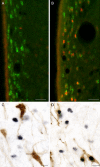Kiss1 neurons in the forebrain as central processors for generating the preovulatory luteinizing hormone surge
- PMID: 16793876
- PMCID: PMC6673844
- DOI: 10.1523/JNEUROSCI.1618-06.2006
Kiss1 neurons in the forebrain as central processors for generating the preovulatory luteinizing hormone surge
Abstract
Kisspeptins are neuropeptides encoded by the Kiss1 gene, which have been implicated in the neuroendocrine regulation of gonadotropin-releasing hormone (GnRH) secretion. The goal of this study was to test the hypothesis that activation of Kiss1 neurons in the anteroventral periventricular nucleus (AVPV) is linked to the induction of the preovulatory luteinizing hormone (LH) surge in the rat. First, we determined that levels of Kiss1 mRNA in the AVPV peaked during the evening of proestrus, whereas Kiss1 mRNA in the arcuate nucleus (Arc) was at its nadir. Second, we corroborated this observation by demonstrating that Kiss1 mRNA is increased in the AVPV at the time of an estrogen (E)- and progesterone-induced LH surge in ovariectomized animals, whereas in the Arc, the expression of Kiss1 mRNA was decreased. Third, we found that most Kiss1 neurons in the AVPV coexpress the immediate early gene Fos coincidently with the LH surge, but virtually none coexpressed Fos on diestrus. In contrast, Kiss1 neurons in the Arc were Fos negative at the time of the LH surge as well as on diestrus. Finally, we found that most Kiss1 neurons in the AVPV and Arc express estrogen receptor alpha mRNA, suggesting that E acts directly on these neurons. These results suggest that Kiss1 neurons in the AVPV play an active role in mediating the effects of E on the generation of the preovulatory GnRH/LH surge on proestrus.
Figures








Similar articles
-
Circadian regulation of Kiss1 neurons: implications for timing the preovulatory gonadotropin-releasing hormone/luteinizing hormone surge.Endocrinology. 2009 Aug;150(8):3664-71. doi: 10.1210/en.2009-0247. Epub 2009 May 14. Endocrinology. 2009. PMID: 19443569 Free PMC article.
-
Reduced responsiveness of kisspeptin neurons to estrogenic positive feedback associated with age-related disappearance of LH surge in middle-age female rats.Gen Comp Endocrinol. 2013 Nov 1;193:121-9. doi: 10.1016/j.ygcen.2013.06.024. Epub 2013 Jul 10. Gen Comp Endocrinol. 2013. PMID: 23851104
-
Involvement of anteroventral periventricular metastin/kisspeptin neurons in estrogen positive feedback action on luteinizing hormone release in female rats.J Reprod Dev. 2007 Apr;53(2):367-78. doi: 10.1262/jrd.18146. Epub 2007 Jan 10. J Reprod Dev. 2007. PMID: 17213691
-
Minireview: kisspeptin neurons as central processors in the regulation of gonadotropin-releasing hormone secretion.Endocrinology. 2006 Mar;147(3):1154-8. doi: 10.1210/en.2005-1282. Epub 2005 Dec 22. Endocrinology. 2006. PMID: 16373418 Review.
-
The role of kisspeptins and GPR54 in the neuroendocrine regulation of reproduction.Annu Rev Physiol. 2008;70:213-38. doi: 10.1146/annurev.physiol.70.113006.100540. Annu Rev Physiol. 2008. PMID: 17988212 Review.
Cited by
-
Kisspeptin excitation of GnRH neurons.Adv Exp Med Biol. 2013;784:113-31. doi: 10.1007/978-1-4614-6199-9_6. Adv Exp Med Biol. 2013. PMID: 23550004 Free PMC article. Review.
-
DNA Methylation Patterns in the Hypothalamus of Female Pubertal Goats.PLoS One. 2016 Oct 27;11(10):e0165327. doi: 10.1371/journal.pone.0165327. eCollection 2016. PLoS One. 2016. PMID: 27788248 Free PMC article.
-
Unaltered Hypothalamic Metabolic Gene Expression in Kiss1r Knockout Mice Despite Obesity and Reduced Energy Expenditure.J Neuroendocrinol. 2016 Oct;28(10):10.1111/jne.12430. doi: 10.1111/jne.12430. J Neuroendocrinol. 2016. PMID: 27601011 Free PMC article.
-
BAX-dependent and BAX-independent regulation of Kiss1 neuron development in mice.Endocrinology. 2010 Dec;151(12):5807-17. doi: 10.1210/en.2010-0783. Epub 2010 Oct 6. Endocrinology. 2010. PMID: 20926580 Free PMC article.
-
Neurochemical Characterization of Neurons Expressing Estrogen Receptor β in the Hypothalamic Nuclei of Rats Using in Situ Hybridization and Immunofluorescence.Int J Mol Sci. 2019 Dec 23;21(1):115. doi: 10.3390/ijms21010115. Int J Mol Sci. 2019. PMID: 31877966 Free PMC article.
References
-
- Barbacka-Surowiak G, Surowiak J, Stoklosowa S (2003). The involvement of suprachiasmatic nuclei in the regulation of estrous cycles in rodents. Reprod Biol 3:99–129. - PubMed
-
- Barraclough CA (1961). Production of anovulatory, sterile rats by single injections of testosterone propionate. Endocrinology 68:62–67. - PubMed
-
- Berghorn KA, Bonnett JH, Hoffman GE (1994). cFos immunoreactivity is enhanced with biotin amplification. J Histochem Cytochem 42:1635–1642. - PubMed
-
- Berghorn KA, Le WW, Sherman TG, Hoffman GE (2001). Suckling stimulus suppresses messenger RNA for tyrosine hydroxylase in arcuate neurons during lactation. J Comp Neurol 438:423–432. - PubMed
-
- Brailoiu GC, Dun SL, Ohsawa M, Yin D, Yang J, Chang JK, Brailoiu E, Dun NJ (2005). KiSS-1 expression and metastin-like immunoreactivity in the rat brain. J Comp Neurol 481:314–329. - PubMed
Publication types
MeSH terms
Substances
Grants and funding
LinkOut - more resources
Full Text Sources
Other Literature Sources
